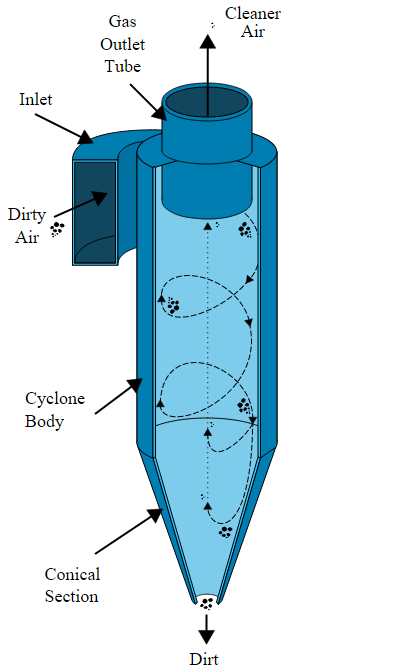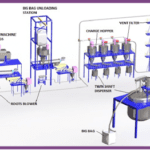CYCLONE SEPARATOR
A cyclone separator, also known as a cyclone dust collector, is a device used to separate particles from a gas or liquid stream based on their size and density. It is commonly used in industrial settings to remove solid or liquid contaminants from air, gas, or liquid streams.
The principle behind a cyclone separator is the centrifugal force generated by the swirling motion of the gas or liquid inside the separator. Here’s how it typically works:
Inlet: The contaminated gas or liquid stream is introduced into the cyclone separator through an inlet. The inlet is designed in such a way that it creates a spiral or helical flow pattern inside the separator.
Swirling Motion: As the gas or liquid enters the separator, it starts to swirl in a downward spiral due to the design of the separator. This swirling motion creates centrifugal forces that push the heavier particles towards the outer wall of the separator.
Separation: As the gas or liquid stream continues to spiral downward, the centrifugal forces cause the particles with higher mass or density to move towards the outer wall of the cyclone separator. These particles then slide down the wall and collect at the bottom of the separator, forming a particle or liquid collection zone.

4. Clean Gas or Liquid Outlet: The purified gas or liquid, with a reduced concentration of particles, continues to move upwards in the cyclone separator. At the top, there is an outlet through which the clean gas or liquid can exit the separator. In some cases, a secondary outlet may be present at a different level to allow for the removal of smaller particles or fines.
5. Particle or Liquid Discharge: The collected particles or liquid in the bottom of the separator can be periodically discharged or removed from the separator through a separate outlet. This outlet is typically located at the bottom or side of the separator and may be equipped with a valve or discharge mechanism.
Cyclone separators have several advantages:
Simple design and operation: Cyclone separators have a relatively simple construction and do not require any moving parts or power supply to operate. This makes them easy to maintain and cost-effective.
High efficiency: Cyclones can achieve high separation efficiencies, especially for larger particles. They are particularly effective for removing coarse solids from gas or liquid streams.
Versatility: Cyclone separators can be used in various industries and applications, including dust collection in industrial processes, gas-solid separation in power plants, and liquid-solid separation in wastewater treatment systems.
Compact size: Cyclones are compact and can be easily integrated into existing systems or mounted in tight spaces.
Minimal maintenance: Due to their simple design, cyclone separators have minimal maintenance requirements and can operate for long periods without the need for frequent cleaning or replacement of parts.
It’s important to note that the efficiency of a cyclone separator can be influenced by factors such as the inlet velocity, particle size distribution, and the specific design and dimensions of the separator. Optimization of these parameters is crucial to achieving optimal separation performance.
KEY BENIFITS
- Easy to install or maintain
- No moving parts
- Easy to dispose collected matter
- Effective dust separation

